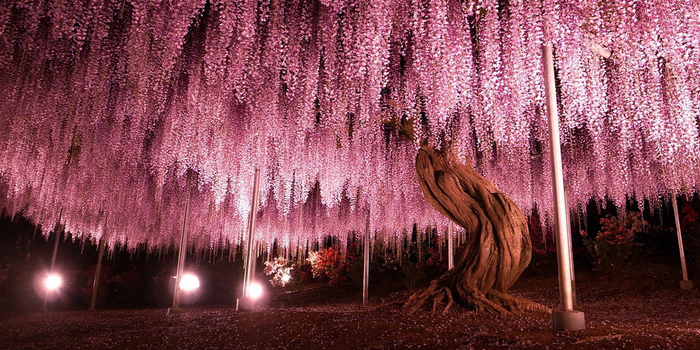Environment
This 144-Year-Old Wisteria In Japan Looks Like A Pink Sky
Native to China, Korea and Japan, wisteria is a genus of flowering plants in the legume family

Native to China, Korea and Japan, wisteria is a genus of flowering plants in the legume family, Fabaceae (Leguminosae), which includes ten species of woody climbing vines. First introduced from China to the United States for horticultural purposes in 1816, and the Japanese wisteria was introduced around 1830.
There’s an unusual way of spotting the difference between two most common wisteria species, the Japanese wisteria (W.floribunda) and the Chinese wisteria (W.sinesis) is the direction the vines twines when viewed from above. Clockwise for the Japanese wisteria and counter clockwise for the Chinese wisteria. Although the flowers of some varieties are edible and even used to make wine, other varieties are said to be toxic to humans and animals. Expert identification is recommended before planting or consuming wisteria.
These hardy climbing, twining, vines grow well even in poor soil and are now considered an invasive species in many parts of the U.S., especially the Southeast, due to their ability to overtake and choke out other native plant species. Wisteria will use any structure to climb and ultimately destroy it, if not from strangulation, then from its sheer weight.
The largest known wisteria in the world is in Sierra Madre, California. This giant wisteria, of the Chinese lavender variety, was planted in 1894 and measures over 1 acre (4047 sq. m) in size and weighs an estimated 250 tons.
To counter the immense weight of these plants, the famous wisteria in Japan’s Ashikaga Flower Park in Tochigi Prefecture, planted around 1870, and spanning half an acre (around 1,990 sq. m), has steel supports to hold the vines up which allows visitors to stroll under the stunning canopy of hanging purple and pink blossoms.
The park features more than 150 wisteria trees with colors ranging from purple to pink to white and yellow. Apart from the amazing 150 year old wisteria, the 80m long tunnel with its white wisteria canopy is another favourite highlight at the park.
The photographs below show the magnificence of Japan’s largest and oldest wisteria, still thriving at the Ashikaga Flower Park and creating a surreal, fairy-tale like ambiance every spring.
For the best show of blossoms, plan your visit from mid-April to mid-May and, if time allows, perhaps visit a few of the other wisteria gardens and festivals.
For more info visit: Best places to see wisteria in Japan
Typos, corrections and/or news tips? Email us at Contact@TheMindUnleashed.com
